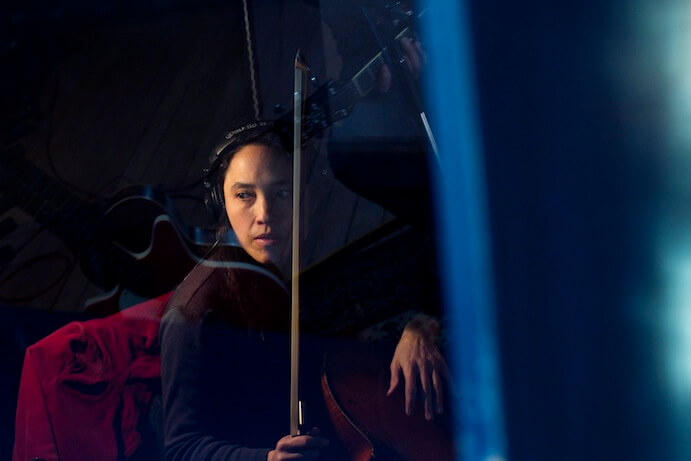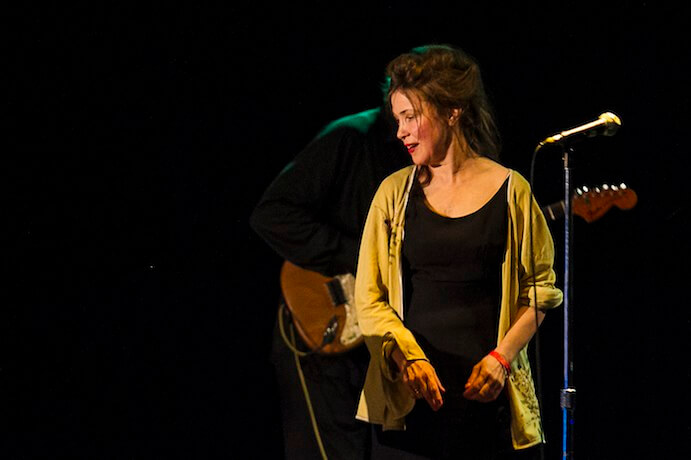Vancouver New Music wrapped its season on Saturday, April 18, 2015 with a sold-out concert at the Orpheum Annex simply entitled “Voices and Strings. In the pre-concert talk, conductor and artistic director Giorgio Magnanensi described the theme for the night as the exploration of “song” – what defines a song, after all, and what forms of expression can it take? The program sought to keep these questions at the top of listeners’ minds, and succeeded in doing with four featured pieces that defied categorization altogether.
The concert began with thirteen musicians on stage for Linda Catlin Smith‘s Les fleurs anciennes (2000). Smith composed the piece based on music from the 14th century, taking specific interest in the “ars subtilior” style from France which was noted for its complex yet subtle choral rhythms. Although inspired by and borrowing techniques from the past, Les fleurs anciennes sounded truly contemporary, thanks in large part to Smith’s masterful arrangement for string orchestra as stand-ins for voices. The performance, however, felt parched and loose as the musicians played their individual parts well, though failed at times to breath together as a whole. A piece of this nature required intense concentration right from the start and was perhaps not the best choice for an opening number as a result. Les fleurs anciennes was otherwise an innovative take on a medieval song form, subdued in tone but chock full of microscopic details beneath the matte surface.
The Canadian premiere of Jay Schwartz‘s Music for Orchestra III (2010) followed with a similarly dense tectonic soundscape. Here, the musicians were air tight and sharply focused on the task of sounding larger than they were in numbers, especially since the piece was originally written for a larger ensemble. The result was a highly controlled and well contained mass of sound, emerging from barely audible harmonics to a state of full resonance, expanding and thickening in unison before the sustained note began to descend like a glacial glissando. One could imagine this piece as a gradient of moods revealing different tonal colours as it shifted – nothing seemed to move when in fact everything was moving all the time. In this way, Music for Orchestra III was akin to a moiré pattern designed for the ears. The piece ended with a unexpectedly rapid tumble from the upper registers, as if to negate the past twenty minutes of careful build-up; it was a surprising moment of cheekiness from Schwartz which got the audience laughing, relieving them of the tension held just moments prior.

Peggy Lee– Photo by Victoria Johnson
Linda Bouchard‘s Réfraction (2015) made its world premiere after the intermission, adding eight more musicians to the all-strings ensemble. Commissioned by Vancouver New Music for this specific occasion, Réfraction was Bouchard’s personal exploration of song and its fundamental qualities: lyricism, beauty, and expressiveness. The piece interpreted these ideas in a playful manner, resulting in a flurry of shimmering textures built upon the sounds of muted pizzicato, snapping strings, and bows played col legno. As such, Réfraction revealed the physicality of the musicians in a way that corresponded to the tactile sounds they were making, resulting in a performance that embodied the spirit of dance somehow.
Peggy Lee & Mary Margaret O’Hara wrapped up the concert with their own premiere of 2 cans and a string thing (2015), a piece featuring improvisation on cello and voice with accompaniment by the string ensemble. This performance was practically one foot in the doorway of free jazz, as O’Hara used her signature vocal stylings to render her voice into a one-of-a-kind instrument of the wildest child-like abandon. Sometimes she whistled, made undecipherable noises with her breath, and sometimes she spoke words while half-singing half-scatting. No matter the shape and form of her phrases, Peggy Lee followed closely on the cello with fluid and virtuosic technique, turning her instrument into a voice that equalled O’Hara’s in elasticity (no easy feat). The rapport between the two of them was fabulous to watch and a delight to listen to, and it was a pleasure to hear the ensemble play in an unabashedly lush manner for once.
Though the night’s program did not provide concrete answers as to how a song is to be defined, it did offer a diverse set of interpretations of the word for consideration while also highlighting the works of several female composers and performers in Canada. It was a short but rich showcase of what Vancouver New Music has to offer and an imaginative send-off for the season.




















